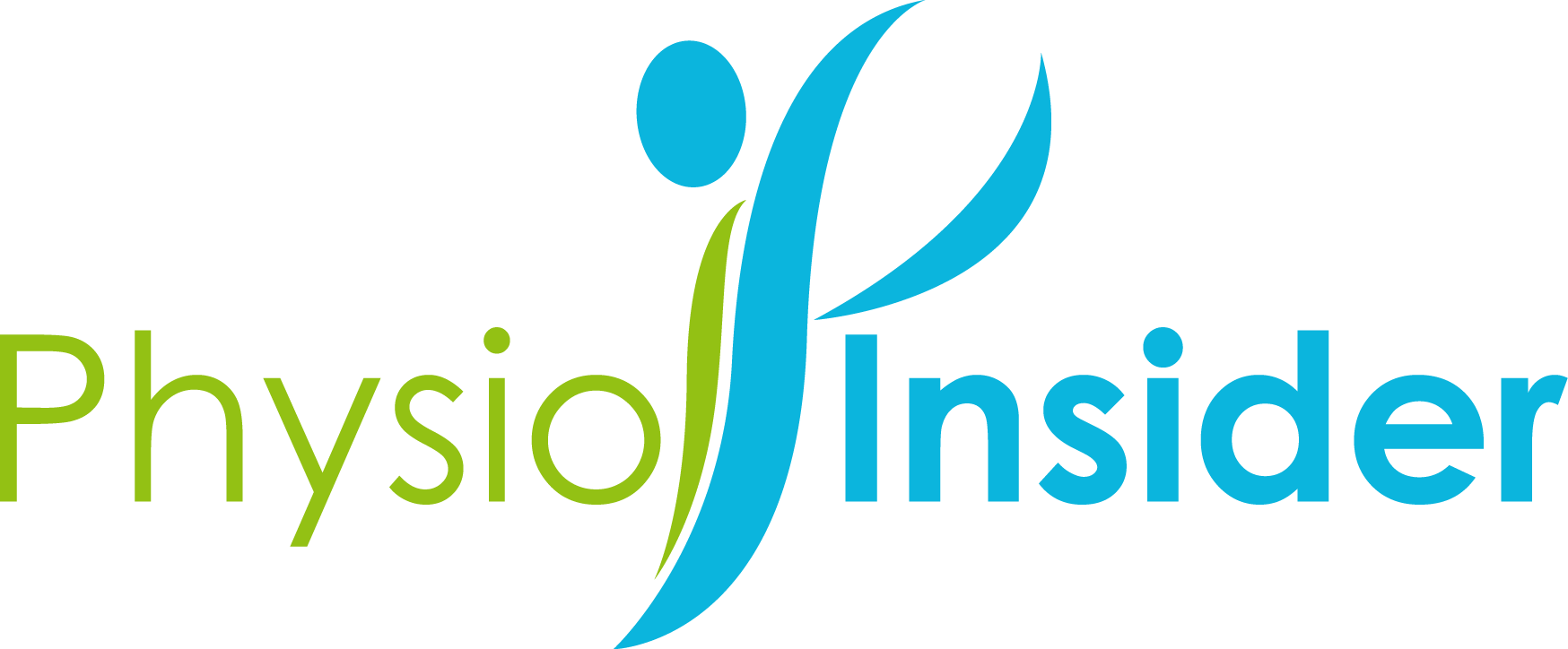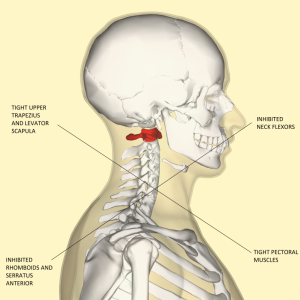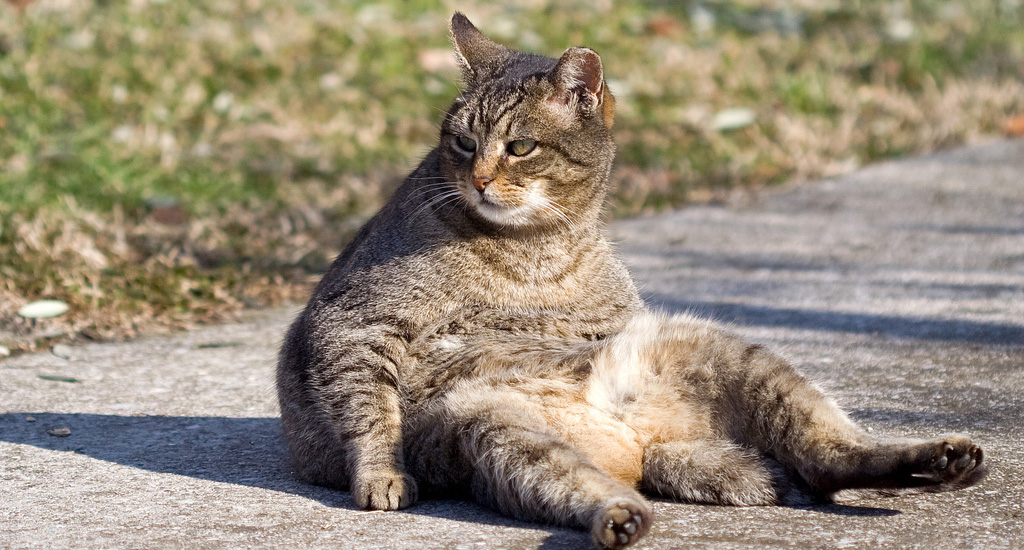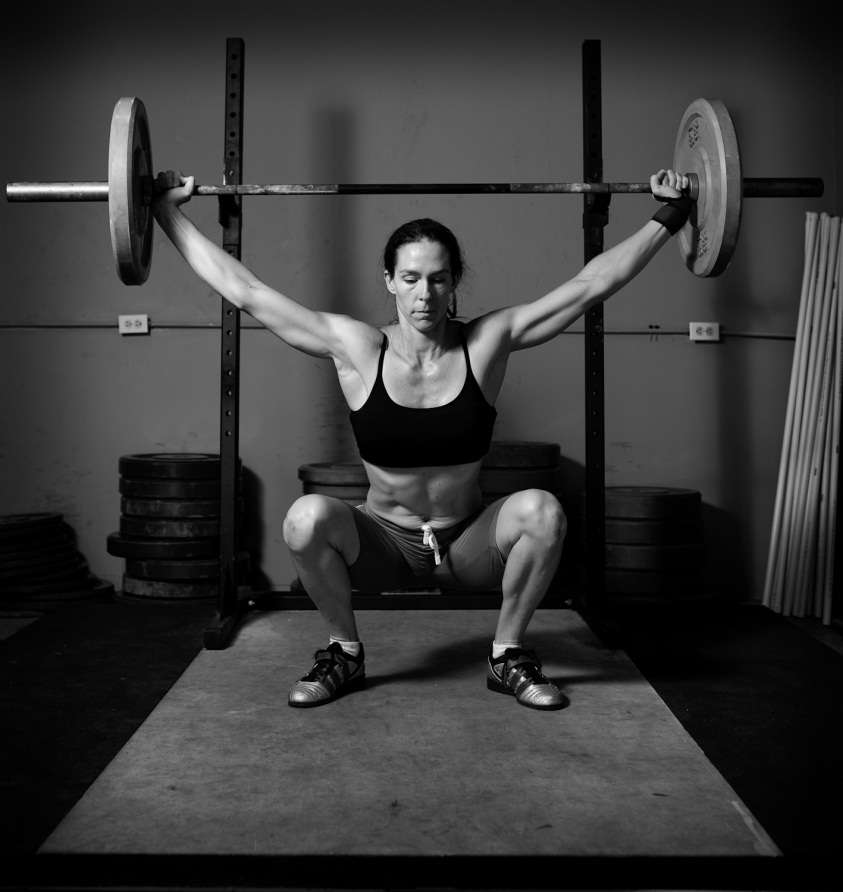Neck Problems:
As discussed in the “Physical Assessment & Imaging” section, a lot of common findings such as degenerative disease or even arthritis at the spine that people used to and continue to panic about are often not meaningful. The latter is because these findings are commonly found even with the non-symptomatic population.
However, a lot of neck problems originate from poor posture at the level of the neck. This is especially true for people who spends ++ hours in front of the computer or teachers who spends a lot of time doing corrections with their heads in a forward position.
As shown on image to the left, when a person has his head protruded or in a forward position, it would stretch out the muscles at the back of the neck. Our body would try to pull the head backwards to reach an equilibrium. In an effort to regain a neutral spine, the muscles (namely the upper traps & the levator scapula) have to work even harder and eventually get even tighter.
Note: This is one of the reasons why people who goes for massages feels better and loosened up right after a massage but these muscle groups tends to tighten up after a short while. Essentially, massaging these areas would free up tension but the upper traps would always tighten up if you do not make a conscious effort to straighten up the cervical spine & to perform stretches regularly.
Suggested Exercises To Improve Neck / Cervical Posture:
1. Cervical Retraction:
1 – Tuck in your chin + fixate on something at eye level at all times.
2 – Glide your head backwards as much as possible without moving the shoulders.
Parameters: 2 x 10 reps by the hour.
2. Snow Angels:
1 – Stand against a wide wall with head touching the wall and tuck in your chin.
2 – Keep your hips and knees slightly bent to ensure that the lower back is leaning flat against the wall.
3 – With back of shoulders, elbows, and wrists touching the wall, raise the straightened arm up and down as if making snow angels against the wall.
Parameters: 20 reps up and down, as often as permitted.
Note: It is alright if you cannot have shoulders, elbows, and wrist against wall due to a lack of flexibility. You may slowly incorporate one component at a time starting from shoulders to elbows to wrists and gradually work your way up.
3. General Stretches:
For all general stretches of the neck, hold for at least 20 seconds in order for it to be effective and perform 3-5 reps at least 3 times a day. Focus more on muscles that are actually tight and stop when a good stretch is felt. Tissues should notbe stretched to point when it is painful.
Upper Trapezius Stretch:
Levator Scapula Stretch:
Sternocleidomastoid Stretch:
Pectoralis Major & Minor Stretch:
Note: Some videos show a few ways to work the same muscle group, it is always good to learn and experiment with different ways of stretching since the positional change might work different fibers of the same muscle group.
Back Problems:
Most minor back aches or stiffness stems from prolonged time spent in front of the computer, sedentary lifestyle (PART 1) or lifting-related injuries (PART 2).
PART 1 – BACK INJURIES FROM PROLONGED SITTING / SEDENTARY LIFESTYLE:
Our back muscles as long as our abdominal muscles would become weak with prolonged time spent sitting slouched. When you are sitting slouched, the back musculatures are lengthened (stretched out) and weakened as well; the abdominals, being underused, become weakened as well but in a shortened position.
Note: Weakened muscles lead to instability of the lumbar spine and also slouching puts excessive stress on the discs and can aggravate symptoms for people with lumbar disc herniation.
Also it does not matter whether you are sitting at the office, on the couch, in your car, just sit up as erect as possible! If necessary, use a lumbar roll / rolled up thick towel or hoodie and place it horizontally behind the lower back or at the level of the back that is painful for those who are symptomatic. This would accentuate the extension of the lumbar spine (natural curvature) providing relief especially for prolonged sitting.
Suggested Exercises To Improve Posture Of The Lumbar Spine:
Disclaimer: These exercises are meant to help improve posture of the lumbar spine and may not be suitable for people with symptomatic back problems or symptoms (pain, numbness, tingling, etc) radiating down the leg. Please consult a healthcare professional when in doubt.
The exercises shown on the website is very similar to what I usually show my own patients, but if you know of better ways to work the same tissues then feel free to stretch in other ways. The pain or stretch should be tolerable at all times when exercising. For all general stretches of the neck, hold for at least 20 seconds in order for it to be effective and perform 3-5 reps at least 3 times a day. Focus more on muscles that are actually tight and stop when a good stretch is felt.
1. Snow Angels:
1 – Stand against a wide wall with head touching the wall and tuck in your chin.
2 – Keep your hips and knees slightly bent to ensure that the lower back is leaning flat against the wall.
3 – With back of shoulders, elbows, and wrists touching the wall, raise the straightened arm up and down as if making snow angels against the wall
Parameters: 20 reps up and down, as often as permitted.
Note: It is alright if you cannot have shoulders, elbows, and wrist against wall due to a lack of flexibility. You may slowly incorporate one component at a time starting from shoulders à elbows à wrists and gradually work your way up.
2. Pelvis Rocking Back & Forth or Cat & Dog Stretch:
Both stretches are great for mobility at the pelvis, the “Pelvic rocking back & forth” is more appropriate for those who work in an office setting or where space is more limited.
Pelvis Rocking Back And Forth:
Cat And Dog Stretch:
3. Lumbar Extensions or Cobra Pose:
The lumbar extension exercise is actually better done while lying flat on your stomach (Cobra Pose) for the reason being the back musculatures are relaxed while the arms are doing all the pushing. This is particular true for people with back strains; you don’ t want to contract back muscles forcefully when they are irritated.
1 – Lumbar Extension In standing:
2 – Lumbar Extension In Supine (Cobra Pose):
4. General Stretches:
For all general stretches of the back, hold for at least 20 seconds in order for it to be effective and repeat 3-5 reps at least 3 times a day. Focus more on muscles that are actually tight and stop when a good stretch is felt. Tissues should not be stretched to point when it is painful.
Piriformis Stretch:
Standing Hamstring Stretch:
More Hamstring Stretch Positions:
Quad Stretch:
ITB Stretch:
Psoas Stretch:
Latissimus Dorsi stretch:
Back Problems:
Part 2 – BACK INJURIES RELATED TO LIFTING:
Often in physiotherapy, we do not see a lot of professional movers getting injured at the back. This is partially because these workers are generally pretty strong to begin with, but more importantly is the technique they use for lifting.
People who injury their back this way are usually those who are not used to lifting and those who does a lot of repetitive lifting with improper form. Lifting an object that is too heavy can potential to lead lumbar strains or even lumbar disc herniation. Essentially the back musculatures are not accustomed to being loaded in such a way but more importantly, the back musculatures are not even supposed to work that hard to begin with!!
The reason why movers do not injure their backs as easily is because they do not depend on their backs…it’s the hips & knees that are doing most of the heavy work! Proper and effective lifting involves bending at the hips, the knees, but not the back and then pushing off with the quads and the gluts while holding on to an heavy object. It is the excessive bending at the back that adds stress to the back.
Proper Lifting Technique:
This video below demonstrates how you are supposed to be using proper body mechanics to lift heavy objects.
General guideline:
1 – Place load closer to your body, you should not be overreaching with your arms
2 – squat down with feet wider apart, most bending happens at hips and knees
3 – Grab on to weight / load with thumbs pointed upwards + load close to your body
4 – Push off at hips + knees while keeping your back as straight as possible while coming up
5 – Do not hold on to a heavy load and rotate your back to either side; always change directions by moving your feet first.
Note: Your back should not be twisting or turning when carrying a heavy load because it’s very easy to injure your back this way.
Functional Retraining:
In theory, one can strengthen all the muscles involved in lifting one muscle group at a time and hope that it would translate into better lifting capacities. This would mean training the gluts, the quads, the hamstrings, calves, etc. However, training muscle groups in isolation does not directly translate into better lifting. This is because muscles at the hips, knees, and ankles must work together to accomplish a single movement; the latter requires not just strength at each unit but motor control.
The single best exercise I prescribe my patients is functional lifting (i.e.: squats with dumbells, barbell, or boxes).
Note: You should consult with your physiotherapist if the pain is constant or getting worse even after a few days of rest; pain radiating down the legs, numbness in the lower extremities, and not being able to sit for long are all signs that the discs might be affected.



